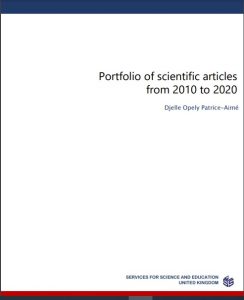Portfolio of scientific articles from 2010 to 2020
Djelle Opely Patrice-Aimé
- Ecole Normale Supérieure Abidjan, LEPPE, Côte d'ivoire
- Keywords:
- Motivation, Social Representations, Factorial Analysis, Emotional Psychology
- Abstract:
- This work aims to study the influence of the socio-educational environment on student performance. It seeks to identify the scope of the relationship between variables or dimensions of school climate and academic performance. From 227 students and 36 public and private high school educators and colleges from the city of Agboville, we assessed their perception with the multidimensional assessment scale of student well-being in schools by Guimard et al., (2014). Multivariate regression analysis and cross-tabulations of variables have elucidated the interactions between a person's behaviors, individual characteristics, and the environment in which they evolve. The data collected showed that school performance depends on the feeling of security, the learning conditions, the state of the teacher- student relationship, the overall satisfaction of students and their well-being in the school environment. This study proves that the best academic results of learners are intimately linked to the establishment of a quality socio- educational environment.
- Allemagne, M-N. et al. (2007). Language disorders, from normal to pathological. In Genesis of language: landmarks and prevention of disorders, Ed. CENTER D’ORTHOPHONIE DE NEUCHATEL, pp 42-45.
- Allemagne, M-N. et al. (2007). The development of communicative competence. In Genesis of language: landmarks and prevention of disorders, Ed. CENTER D’ORTHOPHONIE DE NEUCHATEL, pp 10-11.
- American Psychiatric Association. (2010), Mini DSM IV-TR: diagnostic criteria english version supplemented by codes CIM-10, Masson, ISBN: 978-2-294-71143-5, 365 pages.
- American Psychiatric Association. (2005). DSM-IV-TR: Diagnostic and Statistical Manual of Mental Disorders.
- Revised text, international version with ICD-10 codes. Masson, 1082 pages.
- Brin, F., Courrier, C., Lederlé, E., Masy, V. (1997). Speech therapy dictionary. Orthoedition.
- Brin F., Courrier C., Lederle E., Masy, V.(2004), Dictionary of speech therapy, orthoedition,ISBN: 2-914121-22-9
- Coquet F,. (2002). Examination and intervention: the oral language assessment, in Le orthophonic assessment, Orthophonic rehabilitation, December, n ° 212, pages 13-42.
- Coquet, F. (2004) Oral language disorders in children and adolescents. Isbergues: Ortho Edition Coquet, F., Ferrand, P. (2008) Rehabilitation of speech delays, oral language delays.
- Delahaie M. (2009). The evolution of children’s language. Difficulty with trouble. Resource guide for professionals. Saint-Denis: Inpes
- Guenebaud, M., (2010). My child is dys – health, care, daily life. Liège, éd Déclic.
- Leclercq, A.-L. And Leroy, S. (2012). General introduction to dysphasia. Linguistic characteristics and theoretical approaches. In C. Maillart & M.-A. Schelstraete (ed.). Dysphasias: From evaluation to rehabilitation (pp. 5-34). Paris: Masson, Elsevier.
- Gerin, M., (2013). Dysphasia and language delay: comparison of pragmatic skills. Human medicine and pathology.
- Masson, C., (2014). Early detection of language delays: prevention challenges and development of an action around the identification of language disorders within an Early Medico-Social Action Center (CAMSP). Childhood- Paris-, Universitaires de France, pp. 171- 187.
- Piérart B. (2004a). Dysphasias in children: delayed development or a different language construction, in B. Piérart (Éd.), Dysphasias in children: French-speaking approach, special issue Childhood, n ° 56, 5-19. Paris: University presses of France.
- Rondal, J-A., Seron, X. (2003) Language disorders: Theoretical bases, diagnosis and rehabilitation. Belgium: Mardaga.
- Schelstraete, M.-A. And Colette, É., (2012). Delayed language and dysphasia: diagnostic questions. In ARLD (Ed.), Language & Practices (Num.50, pp. 41-68).
- Schelstraete, M.-A. And Colette, É., (2012). Delayed language and dysphasia: diagnostic questions. In ARLD (Ed.), Language & Practices (Num.50, pp. 41-68)
- Rescorla, L. & Lee, E. C. (1999). Language disorders in young children. In Layton, T. & Watson, L. (Eds.), Nature: Vol. I. Manual of early language disorders in children (pp. 1-38). New York: Delmar.
- Toscanelli A. (1990) “Contribution of language theories on the development of communication, their limits of application in speech therapy intervention for children with multiple disabilities”,
- Tranel, 16, 49-64.
- Vaniere, M., (2012). Impacts of speech and language delay on social interactions between the child and the teacher in the large section of kindergarten, around an activity: The textless book. Thesis to obtain the certificate of speech therapist. University of Nantes.
- Viot, F., (2006) Schooling of dysphasic children: price in educational and pedagogical charge. Dissertation for obtaining the Bachelor of Education Sciences, University of Lyon.

Published
- October 1, 2020
Categories
Copyright
- Copyright (c) 2020 Djelle Opely Patrice-Aimé
License
This work is licensed under a Creative Commons Attribution 4.0 International License.